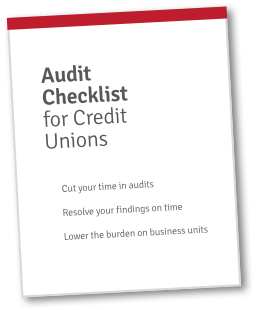Auditing tools and credit union compliance software cost money. If you’re deciding whether to purchase tools, you’ll want to know that the money you spend is actually doing something.
This article is designed to help you decide if audit software can help with your next audit or examination. We’ll cover three evaluative areas to see if you should consider using audit management software.
1. Accountability
Do you worry about accountability in your audit process?Audits require effort from a lot of people. Everyone has a task—or several tasks—to do. It’s critical that everyone understand their responsibilities and their due dates. One missing or incomplete item can hold up other people, or it could mean costly follow-ups, remediation, or a DOR.
One of the primary functions of credit union auditing tools is to increase individual accountability. Robust audit and examination management tools can help you keep track of all the moving parts. It should allow you to see who’s doing what, when things are due, and should allow you to quickly follow up on or request missing or incomplete data.
If your credit union ever struggles with accountability during the audit process, then audit management tools may help. However, if nothing ever slips through the cracks, or if you don’t mind hounding people for documents, answers, or other miscellany, then you may not need audit tools.
2. Ease of Use
Are your audits easy to manage? Can you quickly understand what you’ve done, what you still need, and how to do it?Some of the more rudimentary but still-effective audit tools are spreadsheets, text documents, and email. For many people, these systems are easy to use—after all, they’re mostly used outside of audit and examination purposes.
However, cobbling together deliverable items across multiple platforms can be difficult to keep track of. Also, if you’re concerned about your audit trail (and you should be), you’ll have to make your own.
It’s hard to manage the audit process if you’re having a hard time with the software that you use to manage it. Credit union compliance software reduces the number of programs and platforms you need to successfully complete an audit. Nevertheless, you should never sacrifice ease of use for streamlined efficiency.
If you’re considering using compliance software, make sure it’s intuitive, easy to use, and secure. It should require no special training or expertise—audits ask for enough of your time already. Anybody in your credit union should be able to use it.
3. Shore Up Weaknesses
Does the compliance software bring up as many issues as it solves? Do you need to worry that the tools you use for audits will cause complications down the line?The last consideration is related in many ways to the second. Your audit tools should never make it hard to do your job. If coordinating several different document types—and maintaining version control—are ever an issue, you should look for something better.
For example, you wouldn’t want to send in a “rough draft” of a document. You should deliver only “final drafts” of any documents or answers. You should never be difficult to discern which document has been updated and which hasn’t.
More importantly, you should make sure that the program(s) you use never create complications for you. The best example is email. While it’s great for communication and file sharing under normal circumstances, it can post legal risk during an audit. If one of your auditors finds something unusual through your email communication, then you open your entire email system to legal discovery.
Your audit tools should reduce complications, not open you to new ones. If you’re looking at audit tools, you should look for tools that protect you from lengthy and invasive searches that go beyond what the auditors ask for in the first place.

FREE: Audit Checklist for Credit Unions
4 key principles and 9 questions to jumpstart your audit planning. From leading credit unions.Choosing Credit Union Compliance Software
For a few credit unions, looking for new tools to complete audits and examinations can seem unnecessary. For some smaller credit unions or credit unions who don’t run many audits, some of the more robust credit union compliance software may be overkill.However, if you’re in the market for audit tools, you should look for tools that allow you to try before you buy. There’s no sense in spending your time and money on something that’s supposed to make your life easier if it doesn’t make your life easier.
We’ve written a few guides on surviving audits and examinations that we think will help you in the future. You can find the links below. We’ve also put together a useful NCUA Audit Checklist to help you prepare.
Or, if you’d like to try a free demo or trial of some credit union audit tools, click here.
The Hidden Risks in Credit Union Regulatory Examinations - and How to Avoid Them
5 Strategies to Avoid Risk During Your Credit Union's Next Regulatory Examination






